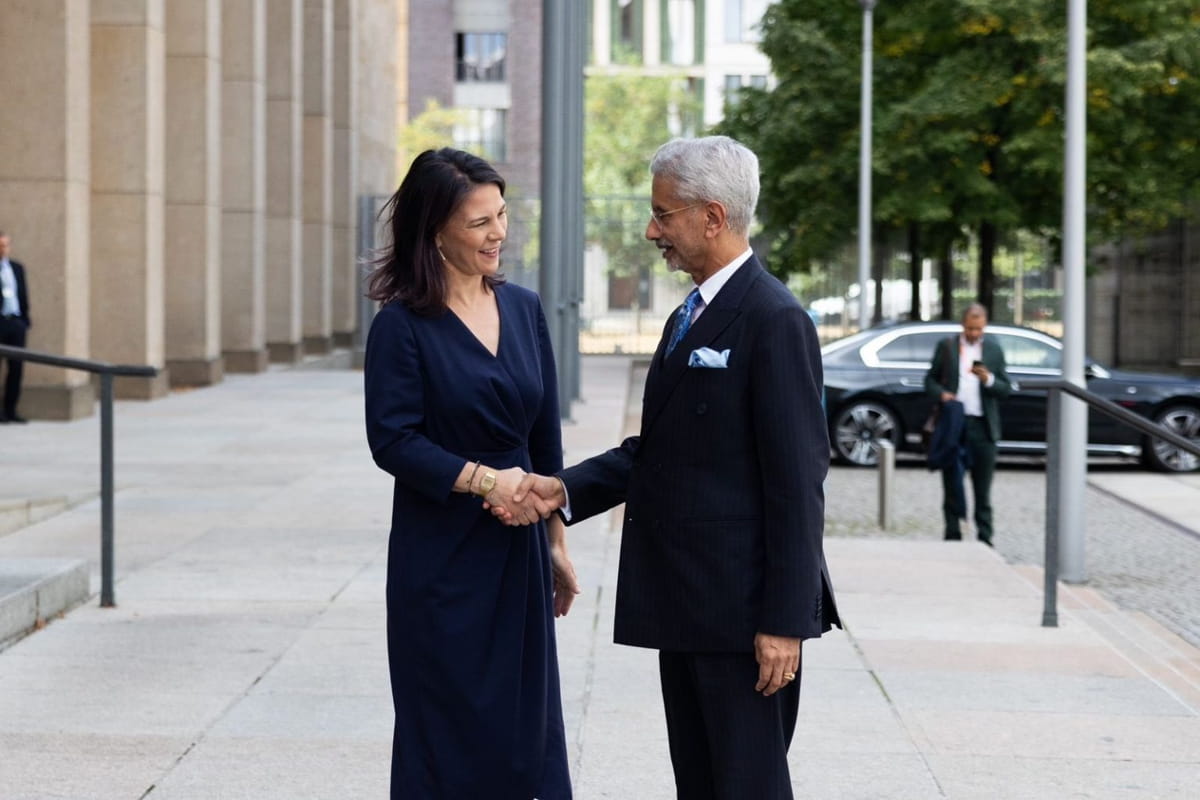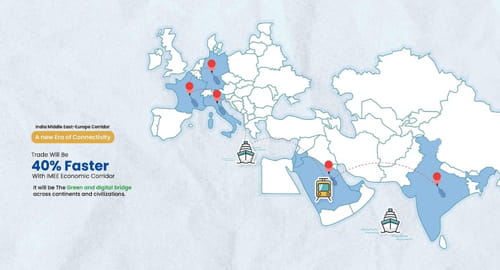
Indian EAM S Jaishankar and German FM Annalena Baerbock in Berlin | MEA
While there are indeed powerful dynamics pushing India and Europe closer together, divergences remain present and there is no guarantee that such a trend would continue automatically on its own if ambitions are not reconciled. This would require a strong and sustained effort on both sides to bridge the differences and proceed where positions are aligned.
In 2024, twenty years after the launch of the strategic partnership, relations between India and the EU are experiencing a new phase, one that is strongly influenced by changes in contemporary geoeconomics. The 2023 Indian G20 represented a key development in the bilateral relationship, especially after the announcement of the India-Middle East-Europe Economic Corridor (IMEC), a connectivity plan to link India with the EU across the Arabian Sea, the Gulf countries, and the Mediterranean. Beyond the project itself, the Memorandum of Understanding (MOU) with four European signatories – the EU, Germany, France, and Italy – signaled a new desire on both sides to strengthen mutual ties and explore new avenues for cooperation, building on the 2021 EU-India Connectivity Partnership and other bilateral engagements. However, rather than being a point of arrival, the unveiling of IMEC is a telling sign that times are changing, with several dynamics pushing Brussels and Delhi closer.
Connectivity, opportunities, and de-risking from China
In a not-so-distant past, India used to be merely on the receiving end of international infrastructural initiatives and connectivity plans, while recently it has become an active promoter of investments in logistics, energy, and transport both it its neighborhood and other regions of the world, primarily in Africa, the Middle East, and South-East Asia. This change alone is a powerful testament to India’s economic rise and progress of the last decade. As the most populous country in the world and the fastest growing G20 member, Delhi is an increasingly attractive economic partner for the EU.
In a global landscape where demographics and development are reshaping the balance of powers, moving it eastwards, Europeans are looking at India also to reduce their dependence on China.
Here lies, in fact, a major common reason for enhanced geoeconomic cooperation: Europe seeks to reduce its reliance on China both as a source of components and raw materials, and as an export destination; on the other side India itself shares this dependency at an industrial level and is keen to explore new opportunities for cooperation. Europe’s quest for de-risking its economy from China translates into the necessity to build new, secure value chains with other rising powers in the Asian continent, and India features prominently in this strategy.
With a working age population expected to reach 1.04 billion by 2030 and a demographic dividend – a period when the labor force of a country grows more rapidly than the total population – lasting beyond 2050, India is well positioned to profit from global redesign of value chains, intercepting investments and developing a stronger manufacturing base. Initiatives like “Make in India” and the vast governmental programs of infrastructure upgrades across the whole country testify the Indian desire to become a more attractive investment destination, showing the convergence of Euro-Indian ambitions.
India also feels encircled by Beijing in its own neighborhood, largely as a consequence of the Belt and Road Initiative (BRI) in the South Asian region and pushback against the Chinese BRI is indeed another major geoeconomic element bringing India and Europe closer, albeit from different angles.
Since launching the Global Gateway, Europe has sought to relaunch its infrastructure plans in developing countries, seeking to counter the influence China has gained overseas thanks to its large – and often controversial – economic offers.
To India, there is an additional layer of national security to this: Beijing’s economic engagements with Delhi’s neighbors have severely restricted Indian connectivity towards Europe, thus limiting access to major trade routes.

India-Middle East- Europe Corridor | Roadcast
Addressing the existing challenges
Despite the renewed enthusiasm for deeper Euro-Indian geoeconomic cooperation, a stronger partnership would have to overcome a set of challenges to be successful. Trade is a powerful vehicle of growth and economic development, but the current picture is quite unbalanced: the EU is India’s biggest trading partner, accounting for 12.2% of total Indian merchandise trade in 2023, while in the same year Delhi barely made it into the EU top 10 trading partners, with just 2.2% of EU trade in goods. This leaves ample room for growth, but India remains at the moment a secondary trade partner for Europeans.
At the same time, the Indian share of global manufacturing value added is remarkably low for the size of its economy, around 3%, compared to China’s 31.2%. Same as trade in goods, the Indian start from a lower base does not necessarily represent an obstacle, yet Europeans have to keep in mind that India cannot immediately substitute production facilities now located in China – and thus should align their expectations accordingly.
Protectionism and regulatory frameworks shortcomings on both sides also should be addressed in order to facilitate trade and economic cooperation. Delhi maintains high tariffs compared to the WTO average, something that has allowed it to protect domestic firms, but also weighs heavily in the minds of foreign investors and European firms wishing to expand in the local market. On the other hand, Europe’s increasingly strict environmental regulations and most importantly the Carbon Border Adjustment Mechanism (CBAM) – essentially an EU carbon tax on imports – worry Indian producers whose goods might not be able to compete in the European market due to the higher carbon intensity of their domestic industries.
A compromise on technology sharing and trade liberalization will be necessary to develop Euro-Indian economic ties to their full potential, and to avoid dangerous discontent on either side.
The biggest challenge, however, is unsurprisingly related to China: both India and the EU have barely reduced their dependence on Beijing in recent years, despite all the talk about de-risking. Most European firms are increasingly worried about China and are reducing their investments there – albeit with notable exceptions like Germany – but European imports from China have been increasing since the pre-pandemic times, showing the limits of European de-risking.
For its part, Indian manufacturing remains heavily dependent on Chinese components and raw materials, including its world-famous pharmaceutical industry, and even despite “Make in India” certain producers still find Chinese imports cheaper than local subsidized goods. Without overcoming these dependencies, any geoeconomic rapprochement between India and Europe would remain suboptimal and unable to truly live up to the ambitions created by recent diplomatic engagements.
The road ahead
To establish a mutually beneficial cooperation, one that allows Europe to rely on India for its de-risking from China and helps the development of a globally competitive Indian industry, both sides should first avoid any complacency. While there are indeed powerful dynamics pushing India and Europe closer together, divergences remain present and there is no guarantee that such a trend would continue automatically on its own if ambitions are not reconciled. This would require a strong and sustained effort on both sides to bridge the differences and proceed where positions are aligned.
To avoid disappointment, a first step would be to clarify whether a free trade agreement should be the final goal or the starting point of this new geoeconomic relationship.
Negotiations have been revamped but a fully-fledged deal remains quite distant in time considering the sheer size and complexity of the two economies – not to mention different preferences in the political economy. Adding to the difficulty are the delicate political equilibria both in Delhi and Brussels: elections in 2024 have brought about in both cities fragmented majorities that would have to thread carefully to ensure consensus behind trade negotiations.
Thus, it would be preferable to begin working on smaller, sectoral agreements to facilitate trade in domains that are both of mutual interest and that can deliver results sooner, helping to build trust. Once those would be in place, they could constitute the building blocks for a wider trade agreement to come at a later stage, preferably one that would include stable regulatory frameworks on services, as the Indian economy is particularly competitive in exporting them.
No relationship can work without dealing with the tough issues and here both India and the EU should not refrain from addressing the divergence of views, maintain an open and frank diplomatic channel.
Understanding the respective concerns and ambitions would be key to forge an effective partnership: Europeans should come to terms with the peculiarities of India’s multi-alignment and understand that deeper EU-India ties would not mean that Delhi is making a choice of camp in global politics. At the same time, Indian policymakers would need to reflect on how values and ideals matter in European domestic policies – and by extension – in its external dealings: persisting Indo-Russian ties, for example, are a key concern for European policymakers and should not be overlooked. To foster mutual understanding, greater interparliamentary, business, and civil society dialogues would be crucial, allowing also the emergence of a larger constituency that seeks to deepen mutual ties. This would make a broader Euro-Indian geoeconomic partnership not just a wish of foreign affairs ministers, but a shared objective of people and firms, providing the right basis for a successful partnership.
(Exclusive to NatStrat)